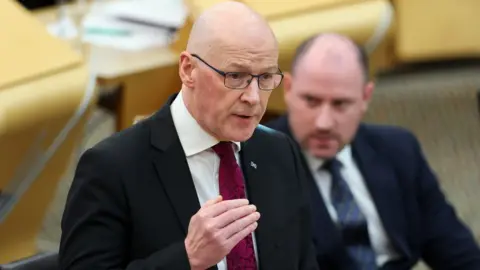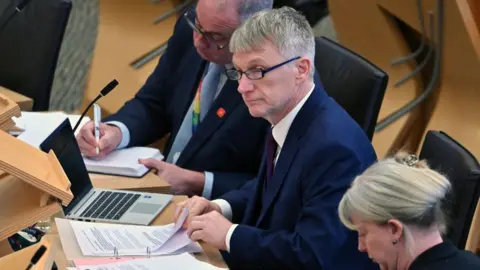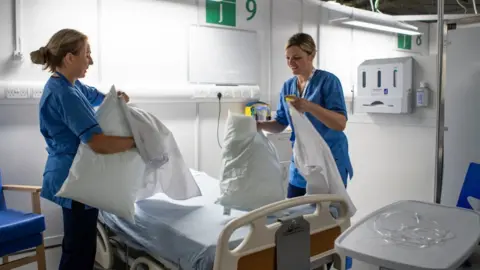Will 'radical' talk finally speed up public service reform?
 Getty Images
Getty ImagesThere's much talk of a "new era" being defined by the second Donald Trump presidency, from trade to defence.
On the home front for Americans, under the direction of Elon Musk, federal government services are being ripped up.
The world's richest man and tech billionaire brings the Silicon Valley mantra of "move fast and break things". There's not much concern for those people and services left scattered and abandoned in his wake.
So facing a new era of public service reform in Scottish government, talk of "radical" change looks relatively calm. But it also looks urgent.
Between public sector unions and local authorities, who have their own mandates and legal powers, Holyrood ministers choose to tread relatively carefully.
The Christie Report
Too carefully for some. It is 14 years since the late trade union leader Campbell Christie set out a report into public service that had been commissioned by one John Swinney.
It concluded, in 2011, that Scotland's public services were "in need of urgent and sustained reform to meet unprecedented challenges".
It went on: "Unless Scotland embraces a radical, new, collaborative culture throughout our public services, both budgets and provision will buckle under the strain."
It had some ideas that were widely accepted, but not widely adopted, starting with a shift to investing early to save money later - in early learning, for instance, which can be linked to better results, less need for learning support in later stages and, eventually, more diversion from crime and a smarter, healthier populace.
"It is estimated that as much as 40% of all spending on public services is accounted for by interventions that could have been avoided by prioritising a preventative approach," said the Christie Report.
It called for public agencies to become less fragmented and cluttered, a priority on tackling inequality, less of a "top down" and more of a "bottom up" approach to how services should support individuals and communities, as well as a clear justification for providing some services free to everyone. Sounds familiar?
It noted some progress towards reform back then, but this was in isolated pockets. The same can be said 14 years later. Audit Scotland, the public spending watchdog, repeatedly says as much.
Last November, it reported that spending plans are not sustainable as they are, so reform is a necessity.
Its report observed: "There is no evidence of large-scale change on the ground, while the Scottish government has not yet fully established effective governance arrangements for a reform programme; does not know what additional funding is required to support reform; and has not provided enough leadership to help public sector bodies deliver change".
 Getty Images
Getty ImagesThe lack of progress is, at least privately, conceded by ministers.
On becoming first minister last year, Swinney did not call for a new, time-killing version of the Christie Commission, but instructed ministers to look for guidance to the first one.
In Ivan McKee as the minister now in charge, summoning the various parts of the government's sprawling agency empire to a "summit" on Monday, St Andrew's House has someone who talks the talk on public service reform more coherently and persuasively than others have done over those years.
Attending were representatives of the same health boards and the same local council areas that have existed since before the Scottish Parliament was first elected. These are the big beasts and big spenders of public services, far more than Holyrood could ever be.
Under instruction from ministers, they have been trying to integrate health with social care to get better outcomes.
There have been mixed results, typically dependent on an individual with effective leadership skills. But the lack of integration of acute services and convalescence support remains one of the NHS's biggest headaches.
Attempts to reform the care sector, including centralisation, have foundered. Initial support from business, unions and local councils fell away.
The single authority model
Ahead of the meeting, in an interview with BBC Radio's Good Morning Scotland, McKee identified a merger of councils and health boards as one of his preferred models for reform.
It's called the single authority model, and the starting point is in Scotland's three island councils.
Shetland, Orkney and the Western Isles/Eilean Siar have three separate health boards as well as the councils set up 50 years ago.
The health boards have become increasingly hard to justify. They require chief executives and various senior officials, paid at national rates, along with back office support. Because they're small, they can't command the best pool of recruits.
Volumes of circulars on clinical and administrative guidance cascade down from national level, and require staff to absorb them. They each require board members, where expertise in clinical issues is thinly stretched.
And after all that, the service they frequently provide to islanders is limited to the air fare to get people to and from hospitals.
In the northern isles, medical landfall is usually Aberdeen. From the Western Isles, Loganair is the key factor in getting patients to services in Glasgow and sometimes Inverness.
 PA Media
PA MediaWhere it might appear appealing to have the full range of medical services on the islands, it is impossible to recruit and retain the specialist doctors required, let alone the funds to pay them.
A doctor's career progression requires a minimum throughput of patients, a bit like a pilot licence requires logged hours in the air.
Pressure has been exerted in the past to get health boards to merge - the northern pair with Grampian, the Western Isles with Highland. There has been similar pressure to get the three Ayrshire councils working together, among other combinations.
But local politics get in the way. Vested interests of elected and employed officials dig in their heels.
Experience of the last major redrawing of council boundaries, in the early 1990s, shows that they cost a lot to remove. So rather than erasing boundaries between geographies, the intention now seems to be removal of the boundaries between services within those geographical areas.
McKee is also keen to press on with merger of back office functions across mainland council areas.
A complex fix
But the difficulties, including the challenge of accountability when things go wrong, become more complex where council boundaries do not match those of health boards. Don't be surprised to find more progress in Scottish Borders and Fife, where they do.
Different accounting and software systems in councils and health boards remain an obstacle to speedy integration.
There are public sector union obstacles as well. The Institute for Fiscal Studies last week showed that there's a windfall gain to be had from a falling number of school pupils.
Teacher numbers could be proportionately reduced, releasing funds for other priorities, it was suggested.
None of the key players were attracted by that, where sustained "teacher numbers" are more the measure of political commitment than pupil outcomes.
The resistance to reform is not just among ministers. It comes from within the agencies they command, from councils which they don't, and from the public - who can often see the need for change in the services they expect, but can also be mobilised in opposition when change feels close to home.
